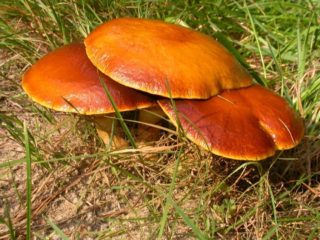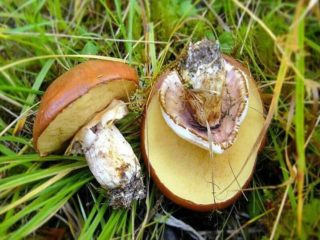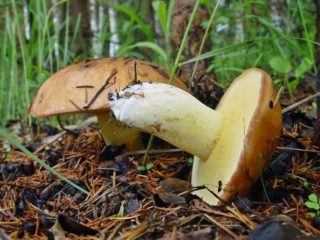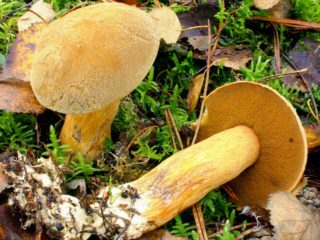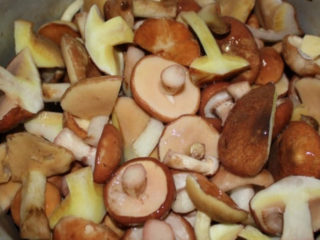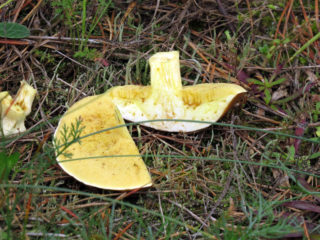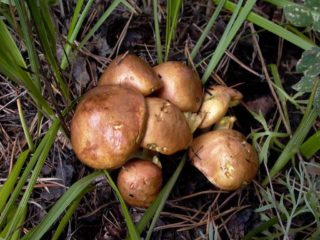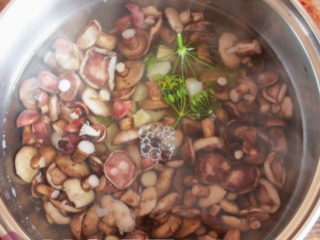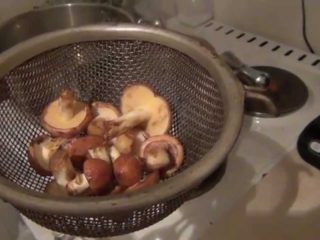Content
White oiler is a small, edible mushroom that belongs to the Oiler family. In some sources you can find its Latin name Suillusplacidus. It does not have any special taste, but it does not cause harm to the body when consumed. After collection, this species must be processed as soon as possible, since its pulp is perishable and susceptible to rotting.
What does a white oiler look like?
The mushroom got its name from the whitish or even light gray color of the cap and stem. At the site of a cut or break, the color of the pulp may oxidize and turn red.
Description of the cap
Small, barely formed Suillusplacidus have small convex caps less than 5 cm in diameter. Their color is white, with pale yellow at the edges.When grown, they have wide flat caps, sometimes concave or cushion-shaped. Their diameter can reach up to 12 cm, the color is dirty gray with hints of olive or beige.
In the photo you can see that the surface of the white oiler is smooth, covered with an oily film, which, when dried, leaves a slight gloss on the cap.
On the reverse side, the cap is covered with dirty yellow tubes, up to 7 mm deep, which extend to the stem, merging with it. Over time, they become olive in color, and a scarlet liquid can be seen in their small pores (up to 4 mm).
The age of Suillusplacidus can be determined by the color of the cap and stem. The porcini mushrooms in the photo are young boletus mushrooms; this can be determined by their pale, non-yellowing cap and clean stem.
Description of the leg
The leg is thin (up to 2 cm in diameter) and long, up to 9 cm, curved, rarely straight, cylindrical in shape. Its thinner end rests on the center of the cap, the thickened base is attached to the mycelium. Its entire surface is whitish, under the cap it is pale yellow. The leg ring is missing. In old fruits, the skin of the stem is covered with dark, brown spots, which merge into one continuous dirty-gray cover. In the photo below, a description of white butter mushrooms, you can see how the color of their legs changes: in small mushrooms it is almost white, in mature ones it is spotted.
Is White Butterfly Edible or Not?
This is an edible mushroom species that does not have good taste. The mushroom is suitable for pickling and pickling. It can also be fried and boiled. It is advisable to collect only young white mushrooms with a clean stem.
Where and how does the white oiler grow?
The mushroom grows in coniferous and cedar forests from late May to early November. There are white boletus, which can be found in deciduous and mixed forests. They grow in the Alps, in the east of North America, in China (Manchuria). In Russia, the white mushroom of the Maslenaceae family is found in Siberia and the Far East, in the central part of the country.
Their main harvest can be harvested in August and September. At this time, they bear fruit abundantly, grow in small families, but single specimens can also be found.
Butterflies are collected a few days after the rain: it is at this time that there are quite a lot of them. You need to look for them on dry, well-lit forest edges - the white oiler does not tolerate shaded, swampy places. Often mushrooms can be found under a layer of fallen pine needles. Mushrooms with a white cap, due to which the boletus is clearly visible against the background of darkened, rotted Christmas tree needles. The fruit body is cut with a well-sharpened knife along the stem at the root. This is done carefully so as not to damage the mycelium.
White oiler doubles and their differences
This mushroom species has practically no doubles. An experienced mushroom picker will not confuse it with other types of mushrooms. Inexperienced lovers of quiet hunting often make the mistake of mistaking swamp boletus and spruce fly for oiler.
Marsh boletus is an edible mushroom that is completely similar to white boletus. To find the differences, you need to carefully examine the mushroom.
Differences:
- boletus is larger, the diameter of its cap can reach up to 15 cm;
- on the reverse side the cap is spongy, convex, passing onto the stem;
- boletus bears fruit very early - from the beginning of May, and is not afraid of frost;
- When cut, the boletus pulp does not change color;
- The stem of the mushroom is clean, covered with a velvety coating, but there are no spots or warts on it.
The boletus boletus, unlike the white buttercup, is a tasty mushroom with a rich taste and aroma.
The fruits of young spruce midge are similar to Suillusplacidus. At the beginning of ripening, it is also light gray in color with a glossy cap. But when cut, the flesh of the mushroom does not darken; this mushroom can be stored for a long time, its stem is short and thick, covered with whitish plates. As it matures, the mushroom darkens and becomes dark gray, making it easier to distinguish it from the white oily mushroom during this period. Also, the cap of the spruce fly is thickly covered with mucus on the outside and inside, which is simply not present on the oil dish.
How to prepare white boletus
After collecting for 3, maximum 5 hours, the white butter must be cooked. First, the skin is removed from them - when cooked, it hardens and begins to taste bitter. They should not be soaked or washed before cleaning; the surface of the mushroom will become slippery and it will become impossible to handle. As soon as each cap is cleared of the film, the mushrooms need to be washed.
Boil the butter for no more than 15 minutes. After this they are salted or pickled. Mushrooms can be dried for the winter, preserved with vinegar or fried.
They are used to prepare the filling for pies, pancakes, dumplings, as well as zrazy, cutlets, and any creamy mushroom or creamy cheese sauce for spaghetti.
Conclusion
White oiler is an edible mushroom that in September can be found everywhere on the edges of coniferous or mixed forests. It does not have high taste qualities, but it does not have poisonous counterparts. You can collect and eat such a mushroom fruit without fear; it is completely harmless even in its raw form.





